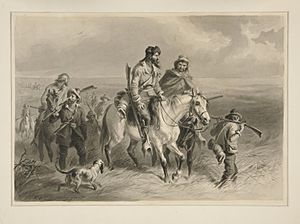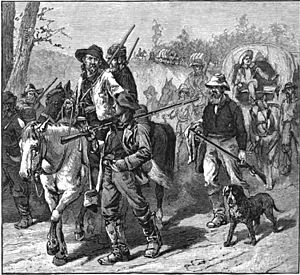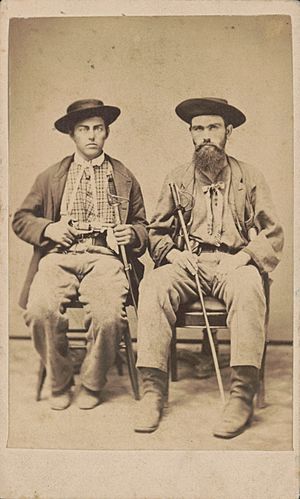Border ruffian facts for kids
The Border Ruffians were a group of people from the state of Missouri who strongly supported slavery. They crossed into the Kansas Territory during the 1850s. Their main goal was to make sure Kansas became a state where slavery was allowed.
These actions were a big part of a violent time known as Bleeding Kansas, which happened mostly between 1854 and 1858. The Border Ruffians did many illegal things. They voted illegally, pretending to live in Kansas when they didn't. They also messed with elections and attacked settlers who were against slavery, destroying their homes and property. Some of them were even proud of their bad reputation. Later, many of them became fighters for the Confederate side during the American Civil War, known as bushwhackers.
Contents
Who Were the Border Ruffians?
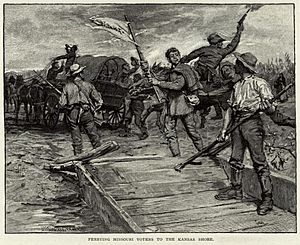
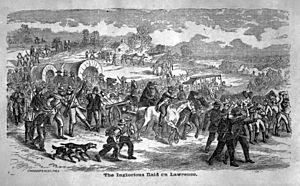
The word "ruffian" means a tough, lawless, or dishonest person. This name was used for these groups because of their actions. One of the first times the term "Border Ruffian" was used for the Kansas slavery issue was in a newspaper called the Herald of Freedom. It was published in Lawrence, Kansas.
The Border Ruffians often carried weapons like revolvers and Bowie knives. They used force to get their way in the fight over slavery in Kansas. A reporter from the London Times visited Kansas in 1856. He wrote about many times when voters were bothered and threatened by Border Ruffians. To fight back, a group called the New England Emigrant Aid Company sent Sharps rifles to Kansas. They sometimes hid these rifles in crates labeled "Bibles."
Many settlers in Kansas at that time did not want slavery. But those who supported slavery were determined to win. When elections happened, armed groups of Border Ruffians took over voting places. They stopped people who were against slavery from voting. They also cast illegal votes themselves, falsely saying they lived in Kansas.
The Border Ruffians mostly came from Missouri. People joked that they voted and shot in Kansas but slept in Missouri. They not only interfered with elections but also attacked settlers who were against slavery. They destroyed their property. This violence led to the phrase "Bleeding Kansas" because so much blood was shed. However, it's important to know that both sides in this conflict used violence and killed people.
The government at the time did not stop the violence. This allowed terrible events to happen, like the attack on Lawrence, Kansas, in May 1856. A U.S. Senator from Missouri, David Rice Atchison, even encouraged the mob that attacked Lawrence. The Border Ruffians' actions made the tensions between the North and South much worse. This eventually led to the American Civil War.
Leaders and Their Followers
The Border Ruffians were not a single organized group. They didn't have regular meetings or clear leaders. No one gave orders to them as a whole group.
Instead, they were inspired by powerful speeches from politicians. These included David Rice Atchison, Benjamin Franklin Stringfellow, and John H. Stringfellow. Another influential person was Rev. Thomas Johnson, a Methodist preacher. Samuel J. Jones and Daniel Woodson, a newspaper editor who supported slavery, also played a role. Atchison, for example, called people from the North "negro thieves" and "abolitionist tyrants." He told Missourians to protect their way of life. He even said they should "kill every... abolitionist in the district" if needed.
Most of the ordinary Border Ruffians did not own slaves. They were often too poor. Their main reasons for fighting were their dislike of people from the North and those who wanted to end slavery. They also feared free Black people living near them. Slavery in Kansas was usually on a small scale, mostly within households. Many Kansans were actually more worried about who owned the land. Historian David M. Potter noted that the slavery issue became very violent in an area where most people didn't care much about slavery either way.
An encyclopedia of Kansas history by Frank W. Blackmar explains how the Border Ruffians were proud of their name and actions. He wrote that while their leaders wanted to destroy the anti-slavery movement and bring slavery to Kansas, the groups themselves enjoyed raiding towns, stealing horses, and causing trouble. Towns and farms along the eastern border were often attacked. Settlers who were against slavery were forced off their land. Elections were disrupted, and violent crimes were committed. When the Civil War began, many of these men became bushwhackers or guerrillas.
The presence of violent groups from both Kansas and Missouri made it hard for settlers on the border to stay neutral.
History of the Conflict
The story of the Border Ruffians is closely linked to Bleeding Kansas. This was a series of violent fights in Kansas from 1854 to 1859. The Kansas Territory was created by the Kansas–Nebraska Act in 1854. This law removed an older rule that had banned slavery in that area. Instead, the people living there would vote to decide if slavery would be allowed.
A count of the population in Kansas in early 1855 showed 8,601 people. Of these, 2,905 could vote, and 192 were enslaved. After the Kansas–Nebraska Act allowed Kansans to vote on slavery, both sides began to encourage settlers to move there. They wanted to increase support for their cause.
Settling in Kansas
People who supported slavery, helped by groups like the Lafayette Emigration Society, set up their own towns. These included Atchison and Leavenworth. Settlers who were against slavery, helped by the New England Emigrant Aid Company, also created their own towns. Examples include Lawrence and Topeka. This led to a deep split among the settlers and their leaders regarding slavery. Soon, extreme groups on both sides started using weapons. The Border Ruffians caused violence for the pro-slavery side. On the anti-slavery side, violence came from groups called jayhawkers.
On November 29, 1854, Border Ruffians helped elect a pro-slavery representative to Congress, John Wilkins Whitfield. After an investigation, it was found that 60% of the votes were illegal.
On March 30, 1855, Border Ruffians helped elect a pro-slavery Territorial Legislature. This group then passed strict laws against speaking out about slavery. People against slavery called it the "Bogus Legislature." This was because Border Ruffians arrived in large numbers, and twice as many votes were cast as there were eligible voters. Because the elections were unfair, Kansas ended up with two governments. One supported slavery, and the other was against it. Both claimed to be the only real government for the entire Territory.
Even with all the Border Ruffians' efforts, more anti-slavery settlers moved to Kansas than pro-slavery ones. In 1857, the pro-slavery group in Kansas suggested the Lecompton Constitution for the future state. They tried to get it approved with more cheating and violence. But by then, there were too many anti-slavery settlers. The U.S. Congress refused to accept it.
Border Ruffians also attacked anti-slavery settlements. They burned farms and sometimes killed men who were against slavery. Most famously, Border Ruffians attacked Lawrence, the anti-slavery capital, twice. On December 1, 1855, a small army of Border Ruffians surrounded Lawrence. But they were forced to leave. This event was called the "Wakarusa War" and had almost no bloodshed.
On May 21, 1856, an even larger force of Border Ruffians and pro-slavery Kansans captured Lawrence. They then looted and destroyed the town.
Settlers who were against slavery fought back. Anti-slavery fighters, led by people like Charles R. Jennison, James Montgomery, and James H. Lane, were known as jayhawkers. They attacked pro-slavery settlers and people thought to be Border Ruffian supporters. Most famously, John Brown, who wanted to end slavery, killed five pro-slavery men at Pottawatomie. In return, a group of Border Ruffians, led by John William Reid, attacked the village of Osawatomie, Kansas after the Battle of Osawatomie.
Help for the Anti-Slavery Cause
Thomas Wentworth Higginson, a minister, helped turn the Massachusetts State Kansas Aid Committee into a well-known organization. This group worked to find settlers who wanted to end slavery. They raised money to help them move to Kansas. They also gave them rifles to use against the Border Ruffians. In 1856, they bought 200 Sharps rifles. These were sent to Kansas hidden in crates. Some of these rifles ended up with John Brown.
Another abolitionist, Henry Ward Beecher, famously said that a Sharps rifle was a "truly moral agency." He believed it had more power against slaveholders in Kansas than a hundred Bibles. He meant that the Border Ruffians would not listen to words but would respect the power of rifles. Records show that from 1855 to 1856, various aid groups from states where slavery was illegal spent at least $43,074.26 on weapons for Kansas. This included rifles, muskets, revolvers, and even a cannon.
In July 1856, the Massachusetts State Kansas Committee and the New England Emigrant Aid Company helped create the Kansas National Aid Committee in Chicago. Thaddeus Hyatt, who led this committee, started collecting money, weapons, food, clothes, and farm supplies. Their goal was to send five thousand settlers to Kansas Territory and give them supplies for a year.
A supply depot was set up in Mt. Pleasant, Iowa. Here, immigrants received horses, wagons, and other supplies, as well as weapons. They were organized into groups and trained. The National Kansas Committee spent about $100,000 between 1856 and 1857 to help the anti-slavery cause.
What Happened Next?
On August 2, 1858, the pro-slavery Lecompton Constitution was rejected by voters. This showed that the Border Ruffians' cause was losing. On January 29, 1861, President James Buchanan signed a bill approving the Wyandotte Constitution. This meant Kansas joined the United States as a Free State, where slavery was not allowed.
During the Civil War
During the American Civil War, the violence on the Kansas-Missouri border did not stop. It actually got much worse. Many former Border Ruffians became pro-Confederate guerrillas, also known as bushwhackers. They operated in western Missouri and sometimes attacked Kansas. Union forces fought to stop them. Farms along the Missouri-Kansas border were looted and burned. People suspected of being guerrillas were killed. In return, bushwhackers murdered Union supporters and suspected informers. Confederate guerrilla leaders like "Bloody Bill" Anderson and William Quantrill were greatly feared in Kansas during the war.
Many Union soldiers fighting the bushwhackers were former jayhawkers. They had strong feelings against the Border Ruffians. Charles R. Jennison formed the 7th Kansas Cavalry Regiment, known as Jennison's Jayhawkers. In late 1861 and 1862, Jennison's Jayhawkers became known for looting and destroying property in Missouri.
Some of the jayhawkers joined a group called the Red Legs. They wore red gaiters (leg coverings) and numbered about 100. The Red Legs worked as scouts for Union troops in Missouri. Jayhawkers and Red Legs looted and burned many towns in Missouri from 1861 to 1863. The destruction of Osceola, Missouri, is shown in the movie The Outlaw Josey Wales.
|


